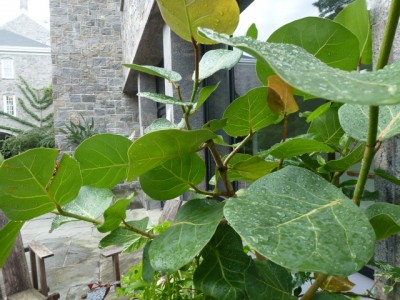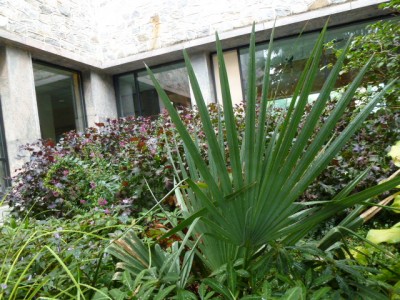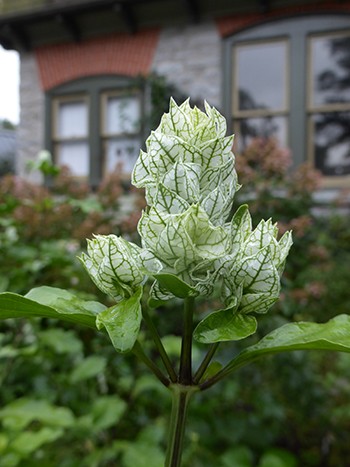Plants of the Week: October 17
Every time I pass by the containers in the Isabel Cosby Courtyard, I stop and stare at the, “cool, big, shiny-leafed thing.” I discovered its name is Coccoloba uvifera, commonly known as sea grape. The common name comes from the green grape-like fruits produced in the summer, which ripen to purple in the fall.
The fruit can be eaten raw, squashed into jam, or fermented into wine. However, Coccoloba uvifera is dioecious, so if you want “grapes,” you will need male and female plants.
As for the “sea” part, Coccoloba uvifera can tolerate dry soil with high salinity, so it can often be found along beaches to safeguard against wind erosion. As a native beach shrub, it prefers full sun, but planted it can live in partial shade and, ironically, doesn’t require much water.
Coccoloba uvifera can reach 8 feet by 8 feet. The mid-spring white flowers are more fragrant than showy, attracting butterflies, bees, and other pollinators. The leaves are an alluringly large and glossy rounded heart shape evergreen. They come in a variety of vibrant colors from red to green to bronze. Other uses for Coccoloba uvifera include: ingredients for leather tanning and dyeing, charcoal, and cabinet making. One can grow sea grapes from the seed pits found inside the fruit.
For a beautiful plant with a variety of uses, Coccoloba uvifera is a fantastic idea, especially if you are designing a beach or desert-themed garden! Photo credit: D. Alvarez
Sabal minor (Cape Hatteras form)
Also located in the Isabelle Cosby Courtyard is Sabal minor (Cape Hatteras form) or dwarf palmetto. It is one of the few palms hardy enough to survive winters north of its native southeastern United States. Sabal minor exists in nature as an understory plant near woodland streams or coastal swamps, so it enjoys shade and wet soil. However, it is still a palm, so it can live with full sun and dry, sandy soil.
Sabal minor can grow up to 10 feet tall particularly if grown in standing water, but seldom grows higher than 3 feet. However, the iconic, fan-shaped leaves can grow out to 6 feet wide. Small, crème-colored flowers bloom around May and produce small black drupes, each containing a seed for a new Sabal minor (Cape Hatteras forms). Thanks to its adaptability and hardiness, Sabal minor (Cape Hatteras form) can be used for a plethora of landscapes. Plant it near a creek, next to a tree as a companion, or perhaps partner it with Coccoloba uvifera listed above for a desert or beach garden! Photo credit: D. Alvarez
Justicia betonica
Justicia betonica exhibits both purple and white coloration, the theme of the 2016 Scott Entrance Garden. Though an evergreen shrub in its native South African habitat, it is a tender annual in Pennsylvania. Justicia betonica possesses distinct, white leaves with green veins on the apices of its stems, between which small, purple flowers bloom from late winter to early summer. It likes full sun, average soil, and average amounts of water, but can accommodate partial shade. Justicia betonica can grow up to 4 feet tall and 3 feet wide.
A special shout-out to Josh Coceano for introducing me to the world of “foliage over flowers.” As I said during our interview, we seem to be kindred spirits regarding plant color preferences. Thank you to everyone for allowing me to join the Scott team! Photo credit: J. Coceano








No Comments